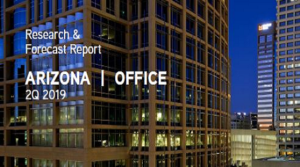Greater Phoenix Office Q2 2019 Report: Great Expectations
 Commentary by Thomas Brophy, Research Director | Arizona at Colliers International, Phoenix
Commentary by Thomas Brophy, Research Director | Arizona at Colliers International, Phoenix
PHOENIX, Arizona — The struggle to quell the natural cynicism which broods over any market analyst is a tale as old as (economic) time. The numbers point up, the wedding bells ring, but the bears in the research department harken the end of the world. In fact, if doom and gloom were a commodity it’s pricing would be parabolic and yet, the gloomier the outlook the more markets seem to defy it. My more natural state of mind, and outlook, is a primordial mix of sarcastic cynicism, the penultimate result of having spent the better part of 20 years in and around CRE. Nonetheless, and not to obviate the ever-growing list of worries, from increasing deficits to trade tensions to slowing global growth to name a mere few, the current-to-near-term outlook is perhaps the best I’ve seen in a decade. Our first two quarters for 2019 have once again exceeded expectations and Phoenix’s influx of population, businesses and employees outpaces the entire country. Yes, the ceiling will eventually be met, however our current pace of expansion is comfortable and not overwhelming. Our title’s inspiration hopes to offer a grain of salt to the passively optimistic tone, not only of myself, but of our second quarter.
Key Takeaways
Not only does Greater Phoenix continue to lead the country in job creation, it also remains #1 for population growth (three years running). During the 12-month period ending in May, preliminary estimates show that employers added 66,500 net new jobs, an increase of 3.2 percent which places Greater Phoenix #1 in overall job growth for the country.
According to the BLS (Bureau of Labor Statistics), over-the-year nonfarm employment rose in 29 of the 51 metropolitan areas with a 2010 Census population of 1 million or more, while employment was essentially unchanged in 22 areas. The largest over-the-year percentage increases in employment in these large metropolitan areas occurred in Phoenix-Mesa-Scottsdale, AZ (+3.2 percent), Orlando-Kissimmee-Sanford, FL (+3.1 percent), and Dallas-Fort Worth-Arlington, TX, and Las Vegas-Henderson-Paradise, NV (+2.9 percent each).
Overall the Greater Phoenix office market performed well during the second quarter, net absorption remained positive with a little over 96,000 square feet absorbed. Employers continue to add workers at a very active pace, fueling tenant demand for office space and fueling new development.
Despite delivering over 1.4 million square feet through the first half of the year, tenant move-ins still outpaced new construction which drove vacancy down to 13.3 percent, 30 basis points (bps) lower than Q1 and 260 bps lower over-the-year. Continued vacancy declines are supporting rent growth with asking rents ending the first quarter at $25.77 per square foot, up 4.5 percent from one year ago.
Investment sales volume increased over-the-quarter by 10 percent to $424 million across 49 transactions. The median price per SF spiked to $172 with cap rates resting at 7.5 percent.
Outlook
The outlook for the Greater Phoenix office market continues to remain bright in both the mid-to-near-term as local businesses continue to expand and new companies continue to bring operations to the Valley. Strong job growth is supporting demand for office space, and with the overall vacancy rate tightening, new development is gaining momentum. Projects totaling more than 2.4 million are under way and development of new projects, or additional phases of current projects, will likely enter the development pipeline in the coming quarters.
On a macro level, in January, as a result of substantial market volatility at the end of 2018, not only did Chairman Powell reverse course on Fed balance sheet reductions, he, as well as other Fed governors, decided to stop ongoing interest rate increases leaving rates at 2.5 percent. In July, Powell et al reiterated their dovish stance by including the possibility of rate cuts in the near term, this sent stocks soaring, both Nasdaq and S&P 500 hit all-time highs with 2Y Treasury yields loosing (8.5) bps.
The net result, markets remained robust for most of the second quarter and the drag on real estate prices many were expecting, as a result of rising rates, has not materialized. With a more dovish Fed, and more talk of QE 4 (Quantitative Easing), expect elevated demand for commercial real estate assets to continue, especially as yields continue to plummet (particularly across fixed income instruments a la Treasury notes) and as investor need for cash flowing vehicles, due in large part to changing demographics, continues to rise.
For full office report Q2 2019 from Collliers click here Arizona Office Report_2Q 2019